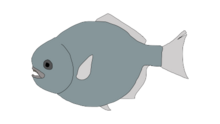Dapedium
| Dapedium Temporal range: | |
|---|---|
 | |
| Scientific classification | |
| Domain: | Eukaryota |
| Kingdom: | Animalia |
| Phylum: | Chordata |
| Class: | Actinopterygii |
| Order: | †Dapediiformes |
| Family: | †Dapediidae |
| Genus: | †Dapedium Leach, 1822 |
| Type species | |
| †Dapedium politum Leach, 1822 | |
| Species | |
| 15+, see text | |
| Synonyms | |
| |
Dapedium (from Greek: δαπέδων dapédon, 'pavement')[1] is an extinct genus of primitive marine neopterygian ray-finned fish. The first-described finding was an example of D. politum, found in the Lower Lias of Lyme Regis, on the Jurassic Coast of England (Leach 1822). Dapedium lived in the Late Triassic to the Middle Jurassic period, from the late Norian to the early Aalenian.[2][3]
Evolution
[edit]Dapedium is one of the most diverse and abundant genera of ganoid fish from the early Jurassic of Europe. Its remains are known from many appropriately-aged lagerstätten throughout western Europe, with some records also known from eastern Europe. It appears to have been relatively rare during the Triassic, especially compared to other members of its family, but saw a large burst in diversification in the wake of the Triassic-Jurassic extinction event. It is thought that most Triassic dapediids had highly specialized feeding strategies or had less armor compared to the heavily-scaled, generalist Dapedium, allowing it to survive the extinction event. These adaptations may have also enabled Dapedium to survive a second extinction event, the Toarcian Oceanic Anoxic Event, although the abundance of Dapedium saw a dramatic decline after that, and it went extinct shortly afterwards. Dapedium was apparently a poor disperser, as despite its ecological success, there are no records of it outside Europe.[3][4]
Species
[edit]
The following species are known:[3][5]
- D. angulifer (Agassiz, 1832) - Early Jurassic (early Hettangian) of England (Blue Lias) (=Tetragonolepis traillii Agassiz, 1832)
- D. ballei Maxwell & López-Arbarello, 2018 - Middle Jurassic (early Aalenian) of Germany (Opalinuston Formation)
- D. caelatum Quenstedt, 1858 - Early Jurassic (early-middle Toarcian) of Germany (Posidonia Shale)
- D. colei Agassiz, 1835 - Early Jurassic (late Hettangian/early Sinemurian) of England (Blue Lias)
- D. dorsalis (Agassiz, 1836) - Early Jurassic (Hettangian/Pliensbachian) of England ("Lower Lias")
- D. granulatum Agassiz, 1835 - late Hettangian/earliest late Sinemurian of England (Blue Lias/Charmouth Mudstone)
- D. magnevillei (Agassiz, 1836) - early Toarcian of France ("Upper Lias")
- D. milloti Sauvage, 1891 - early Toarcian of France
- D. noricum Tintori, 1983 - Late Triassic (late Norian) of Italy (Zorzino Limestone)
- D. orbis Agassiz, 1836 - Hettangian/Pliensbachian of England ("Lower Lias")
- D. pholidotum (Agassiz, 1832) - early-middle Toarcian of Germany (Posidonia Shale)
- D. politum Leach, 1822 - early Sinemurian to earliest late Sinemurian of England (Blue Lias/Charmouth Mudstone)
- D. punctatum Agassiz, 1835 - early Sinemurian to Pliensbachian of England (Blue Lias/Charmouth Mudstone)
- D. stollorum Thies & Hauff, 2011 - early-middle Toarcian of Germany (Posidonia Shale)
The complete fossil of an indeterminate Dapedium is known from the Toarcian of Hungary, marking the only known specimen of this genus from eastern Europe.[4] Records from India are thought to be erroneous.[3]

Appearance
[edit]
The various species of Dapedium ranged from 9 to 40 centimetres (3.5 to 15.7 in) long, and all had an oval to near-circular body. The skin was covered with thick, rhomboid, ganoid (enamel-like) scales. The smallest species so far found is D. noricum.
The skull was armoured with bony dermal plates, which were especially plentiful in the orbital region. These bones bore irregular tubercles. The small pectoral and pelvic fins, along with the extended dorsal and anal fins formed a functional unit with the tail.[6] The tail was short and stout, providing the power for a sudden change in direction while the fish was swimming.
The upper jaw of Dapedium was moveable and could protrude from the mouth, enabling a wider gape to capture larger prey.
Distribution
[edit]
Dapedium lived mostly in the Jurassic seas of Europe, a peripheral continental shelf sea of the Tethys Ocean. Notable finds have been made in Holzmaden, Germany, in Temple Grafton, Warwickshire, England and in Lyme Regis, Dorset, England.
Behaviour
[edit]The strong and pointed dentition suggests that Dapedium was durophagous, feeding on hard-shelled invertebrates, like mussels and sea urchins.[6]
References
[edit]- ^ Roberts, George (1839). An etymological and explanatory dictionary of the terms and language of geology. London: Longman, Orme, Brown, Green, & Longmans. p. 45. Retrieved 31 December 2021.
- ^ Thies, Detlev; Waschkewitz, Jens (2016). "Redescription of Dapedium pholidotum (Agassiz, 1832) (Actinopterygii, Neopterygii) from the Lower Jurassic Posidonia Shale, with comments on the phylogenetic position of Dapedium Leach, 1822". Journal of Systematic Palaeontology. 14 (4): 339–364. Bibcode:2016JSPal..14..339T. doi:10.1080/14772019.2015.1043361. S2CID 130282395.
- ^ a b c d Maxwell, Erin E.; López-Arbarello, Adriana (2018-06-27). "A new species of the deep-bodied actinopterygian Dapedium from the Middle Jurassic (Aalenian) of southwestern Germany". PeerJ. 6: e5033. doi:10.7717/peerj.5033. ISSN 2167-8359. PMC 6026462. PMID 29967726.
- ^ a b Szabó, Márton; Pálfy, József (2020-03-01). "Dapedium sp. from the Toarcian (Lower Jurassic) Úrkút Manganese Ore Formation (Bakony Mts., Hungary) and an overview of diversity of dapediiform fishes". Palaeobiodiversity and Palaeoenvironments. 100 (1): 179–195. Bibcode:2020PdPe..100..179S. doi:10.1007/s12549-019-00390-7. ISSN 1867-1608.
- ^ Hauff, Rolf Bernhard; Thies, Detlev (2011). "A new species of Dapedium LEACH, 1822 (Actinopterygii, Neopterygii, Semionotiformes) from the Early Jurassic of South Germany". Palaeodiversity. 4: 185–221.
- ^ a b Palmer, D., ed. (1999). The Marshall Illustrated Encyclopedia of Dinosaurs and Prehistoric Animals. London: Marshall Editions. p. 37. ISBN 1-84028-152-9.
- Detlev THIES & Annette HERZOG, New information on †Dapedium LEACH 1822 (Actinopterygii, †Semionotiformes), in Mesozoic Fishes 2 – Systematics and Fossil Record, G. Arratia & H.-P. Schultze (eds.): pp. 143-152, Verlag Dr. Friedrich Pfeil, München, Germany – ISBN 3-931516-48-2


 French
French Deutsch
Deutsch



